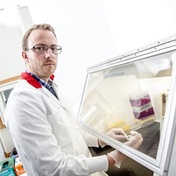A genetic tweak of the unfertilized eggs of macaque monkeys effectively prevented the transmission of diseases typically passed down through the maternal line, U.S. scientists reported.
The hope is that the method could prevent inherited diseases passed from human mothers to their children through mutated DNA in cell "power plants" called mitochondria. Mitochondria play a basic role by producing energy for each cell, but they also contain their own genes, called mitochondrial DNA (mtDNA), the researchers say.
"Mitochondrial genes are very vulnerable to mutations that cause numerous human diseases," noted lead researcher Shoukhrat Mitalipov, from the Division of Reproductive Sciences and the Oregon National Primate Research Center and the Oregon Stem Cell Center, part of Oregon Health & Science University. "Mitochondrial genes are passed to the next generation through the maternal lineage or through the female's eggs," he added. The study demonstrates that mtDNA can be safely removed and replaced in the egg, Mitalipov said. "We show that such experimentally created eggs can be fertilized by sperm and develop into healthy monkeys. This approach can be used in humans to prevent birth defects in patients carrying mitochondrial gene mutations," he said.
The report is published in the Aug. 26 online edition of Nature.
In their experiments, Mitalipov's team collected unfertilized eggs from two female macaque monkeys. They removed the chromosomes -- which contain the genes found in the cell nucleus -- from one female's egg and transplanted this material into the other monkey's egg, from which the nuclear DNA had already been removed. The recipient female's egg retained its original mtDNA.The eggs were then fertilized and as they developed into embryos they were implanted in other monkeys.
That implantation resulted in the birth of healthy twin monkeys, nicknamed Mito and Tracker. These monkeys are the world's first animals derived by this "spindle transfer" process, the researchers say.Tests showed that there was little to no trace of mitochondrial transfer between the mother whose mtDNA was removed and the new twins. According to the researchers, this shows that it is feasible to keep mitochondrial DNA isolated during the transfer process.
"Our approach represents a new gene therapy dealing with repair or replacement of mutated genes before the child is born," Mitalipov said. Diseases caused by mtDNA mutations were first described in 1988. Since then, over 150 mutations associated with human diseases have been identified, Mitalipov said.
These disorders appear throughout life, from newborns to adults of all ages, he said. These include Leber's hereditary optic neuropathy and myoclonic epilepsy with ragged-red fibers, as well as Kearns-Sayre syndrome, which includes symptoms of pigment retinopathy and cardiac disorders, Mitalipov noted.
"More importantly, mtDNA mutations are also increasingly implicated in a range of socially recognizable conditions, including Alzheimer's, Parkinson's and Huntington's diseases, obesity, diabetes and cancer," he said.
Dr. Joshua Hare, professor and director of the Interdisciplinary Stem Cell Institute at the University of Miami Miller School of Medicine, called the work "very exciting."
But he stressed that there are many steps in going from an animal model to a human. "In this case there is going to be a great amount of ethical discussion because you can't really do a clinical trial," he said. "If you created a human like this that human would be alive, and if something went wrong because of the way in which that person was created there would be a lot of ethical dilemmas," he explained.
"This addresses an important problem and I think it could be applicable in humans," Hare said. "It will be very controversial for awhile," he said. "It could be close enough to cloning to worry people. It will be interesting to see what happens in terms of whether or not this is attempted in a human being."
Dr. Jamie Grifo, director of reproductive endocrinology at New York University Medical Center in New York City, who has done similar experiments in mice, agreed that ethical issues will continue to plague this work.
"This kind of work is going to cause people to be nervous and regulators to be really nervous," Grifo said, while defending the research. "Show me the harm," he said. "If you can make healthy babies, what is the harm?" (- HealthDay News, August 2009)




 Publications
Publications
 Partners
Partners














